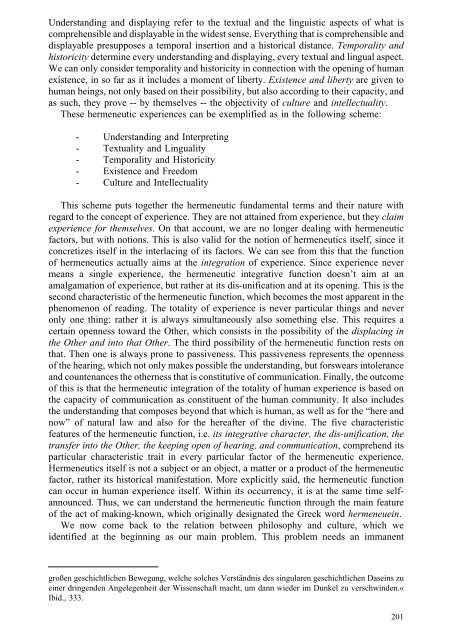[Andrzej_Wiercinski_(ed ... - WordPress.com
[Andrzej_Wiercinski_(ed ... - WordPress.com
[Andrzej_Wiercinski_(ed ... - WordPress.com
You also want an ePaper? Increase the reach of your titles
YUMPU automatically turns print PDFs into web optimized ePapers that Google loves.
Understanding and displaying refer to the textual and the linguistic aspects of what is<strong>com</strong>prehensible and displayable in the widest sense. Everything that is <strong>com</strong>prehensible anddisplayable presupposes a temporal insertion and a historical distance. Temporality andhistoricity determine every understanding and displaying, every textual and lingual aspect.We can only consider temporality and historicity in connection with the opening of humanexistence, in so far as it includes a moment of liberty. Existence and liberty are given tohuman beings, not only bas<strong>ed</strong> on their possibility, but also according to their capacity, andas such, they prove -- by themselves -- the objectivity of culture and intellectuality.These hermeneutic experiences can be exemplifi<strong>ed</strong> as in the following scheme:- Understanding and Interpreting- Textuality and Linguality- Temporality and Historicity- Existence and Fre<strong>ed</strong>om- Culture and IntellectualityThis scheme puts together the hermeneutic fundamental terms and their nature withregard to the concept of experience. They are not attain<strong>ed</strong> from experience, but they claimexperience for themselves. On that account, we are no longer dealing with hermeneuticfactors, but with notions. This is also valid for the notion of hermeneutics itself, since itconcretizes itself in the interlacing of its factors. We can see from this that the functionof hermeneutics actually aims at the integration of experience. Since experience nevermeans a single experience, the hermeneutic integrative function doesn’t aim at anamalgamation of experience, but rather at its dis-unification and at its opening. This is thesecond characteristic of the hermeneutic function, which be<strong>com</strong>es the most apparent in thephenomenon of reading. The totality of experience is never particular things and neveronly one thing: rather it is always simultaneously also something else. This requires acertain openness toward the Other, which consists in the possibility of the displacing inthe Other and into that Other. The third possibility of the hermeneutic function rests onthat. Then one is always prone to passiveness. This passiveness represents the opennessof the hearing, which not only makes possible the understanding, but forswears intoleranceand countenances the otherness that is constitutive of <strong>com</strong>munication. Finally, the out<strong>com</strong>eof this is that the hermeneutic integration of the totality of human experience is bas<strong>ed</strong> onthe capacity of <strong>com</strong>munication as constituent of the human <strong>com</strong>munity. It also includesthe understanding that <strong>com</strong>poses beyond that which is human, as well as for the “here andnow” of natural law and also for the hereafter of the divine. The five characteristicfeatures of the hermeneutic function, i.e. its integrative character, the dis-unification, thetransfer into the Other, the keeping open of hearing, and <strong>com</strong>munication, <strong>com</strong>prehend itsparticular characteristic trait in every particular factor of the hermeneutic experience.Hermeneutics itself is not a subject or an object, a matter or a product of the hermeneuticfactor, rather its historical manifestation. More explicitly said, the hermeneutic functioncan occur in human experience itself. Within its occurrency, it is at the same time selfannounc<strong>ed</strong>.Thus, we can understand the hermeneutic function through the main featureof the act of making-known, which originally designat<strong>ed</strong> the Greek word hermeneuein.We now <strong>com</strong>e back to the relation between philosophy and culture, which weidentifi<strong>ed</strong> at the beginning as our main problem. This problem ne<strong>ed</strong>s an immanentgroßen geschichtlichen Bewegung, welche solches Verständnis des singularen geschichtlichen Daseins zueiner dringenden Angelegenheit der Wissenschaft macht, um dann wi<strong>ed</strong>er im Dunkel zu verschwinden.«Ibid., 333.201


